The core and inner cladding of an optical fiber can provide concurrent coherent and incoherent detection, uniting optical coherence tomography with fluorescence for biomedical imaging.
Kathy Beaudette, Caroline Boudoux, Audrey Laurence, Castor Optics
The design of optical coherence tomography (OCT) systems has evolved significantly in the past three decades by enhancing imaging capabilities, reducing the size of devices, and expanding the scope of clinical applications in fields such as ophthalmology and cardiology (opening image). Central to this wave of innovation has been the development of fiber optics components, such as fiber optics couplers.

The heart and cardiovascular system, for which multimodal OCT is providing new insights. Courtesy of iStock.com/nopparit.
Recent research efforts have aimed to enhance OCT’s information content by merging it with imaging modalities exploiting complementary optical contrasts. An example of multimodal imaging that will be discussed in greater detail in this article is the combination of fluorescence imaging with OCT, which enhances image contrast by incorporating molecular information into the structural images obtained by OCT. Additionally, OCT can be merged with laser treatment techniques by leveraging real-time structural data from OCT to monitor the treatment effect directly.
Recent research efforts have aimed to enhance OCT’s information content by combining it with imaging modalities exploiting complementary optical contrasts.
The combination of these modalities within the same optical path typically uses free-space optics. However, this type of design presents manufacturing challenges, additional mechanical constraints to maintain proper alignment, and, for certain clinical applications such as endoscopy, is not suitable for remote-access imaging. An alternative strategy is to employ fiber optics into an instrument, such as an endoscope, offering a lighter, more streamlined, and alignment-tolerant system. Notably, the double-clad fiber (DCF) is gaining attention from OCT device developers for multimodal imaging, due to its ability to efficiently channel distinct imaging modalities through its core and inner cladding.
DCF coupler
A DCF features a concentric design with two light-guiding regions: a core and an inner cladding. The core generally supports the propagation of a single mode for a specific wavelength range. In contrast, the inner cladding can carry upwards of thousands of modes. This dual-mode guiding capability combines the benefits of both single-mode and multimode fibers while being self-aligned due to the channels’ concentricity.
The core of a DCF can be used for coherent illumination and/or detection, which is suited for interferometric measurements, such as OCT. The inner cladding is adaptable for incoherent detection (e.g., fluorescence and reflectance) or partially coherent detection (e.g., confocal imaging) by tailoring its diameter to specific applications and operational wavelengths. It also presents a larger numerical aperture and surface area than that of the core, resulting in several benefits. One of them is an increased collection efficiency, which provides the advantage of increased detection sensitivity while detecting fluorescent molecules or diffuse reflectance signals. The inner cladding can also support higher power, which enables it to perform more effective laser treatment procedures.
This technology’s potential has already been demonstrated in other photonics applications, such as coherent and incoherent lidar, telemetry, and free-space communications. Applications in biomedical imaging are now coming to the fore.
The advent of DCF and DCF couplers into biomedical imaging has facilitated the integration of OCT with various imaging techniques at a number of different institutions, including fluorescence, reflectance, and confocal imaging, with other advancements, such as hyperspectral imaging in development.
DCF couplers have been developed to couple and decouple signals efficiently through a DCF with minimal loss. These DCF couplers are typically created by fusing and tapering a DCF with a second fiber, usually a multimode fiber1. This arrangement facilitates almost lossless transmission of single-mode signals through the DCF’s core from one port to another and allows for the transfer of multimode signals between the multimode fiber and the DCF’s inner cladding (Figure 1). Additionally, these couplers can be designed for maximum transfer efficiency in different configurations, depending on imaging needs: extraction (from the DCF’s inner cladding to the multimode fiber), injection (the opposite direction), or bidirectional (both directions simultaneously).

Figure 1. A schematic of a double-clad fiber (DCF) coupler used in a bidirectional configuration for concurrent OCT and fluorescence imaging. The DCF (top fiber) carries the OCT signal (red), while the multimode fiber (bottom fiber) carries both the excitation (blue) and collection signal (green). One port of the fiber coupler (bottom right) is terminated to minimize back reflection. Courtesy of Castor Optics.
How it works
The high transfer and transmission ratios of the DCF coupler are enabled through its asymmetric structure, which takes advantage of a difference in etendue between each fiber that is used. The etendue (G) defines the extent, in area and angle, to which light can be emitted or collected. For a fiber optics system, the etendue is described in the formula G = π • S • NA2, where S is the fiber core’s surface area and NA is the numerical aperture2.
The etendue of an optical fiber dictates the number of modes of propagation supported at a given wavelength. In a system with two outputs of varying etendue, statistical mechanics determines that multimode light will couple predominantly into the output with the highest number of available modes. Therefore, using a multimode fiber that has a larger etendue than the inner cladding allows for extraction from the DCF to the multimode fiber (typically >70% of the multimode light).
Inversely, if the DCF inner cladding has a larger etendue than the multimode fiber, the coupler will perform efficiently for the injection from the multimode fiber into the DCF. Transfer and transmission ratios can be estimated using the ratio of etendue from the output port against the total etendue of both fibers. Recent design configurations developed at Castor Optics have allowed for novel DCF couplers with extremely high extraction ratios (typically >90%) and bidirectional transfer (typically >60% in both directions).
Multimode extraction
When performing fluorescence or reflectance measurements in biological tissues, where signals are inherently weak, maximizing the light collection and its transmission from the tissue to the detector is critical. In systems that employ DCF, the core transmits the excitation light, and fibers featuring a large inner cladding are chosen for increased collection efficiency. DCF couplers that are optimized to extract the desired signal from the inner cladding with minimal losses and channel it through a multimode fiber to the detector are used. These fiber components are referred to as extraction couplers.
An innovative use of extraction DCF couplers is showcased in endoscopic imaging for pulmonary vasculature exploration3. The system uses a DCF catheter with a 0.9-mm diameter for high-resolution autofluorescence imaging and OCT in peripheral airways (Figure 2). The authors have demonstrated superior performances when coupling autofluorescence imaging excitation light into the core of the DCF as opposed to coupling it into the inner cladding. This approach ensures tightly focused excitation light while efficiently collecting autofluorescence emission through the DCF’s large-diameter inner cladding. Since the autofluorescence signal has low intensity, the collection efficiency of a multimode fiber combined with the high extraction efficiency of the DCF coupler are vital for favorable performance.

Figure 2. In vivo OCT and autofluorescence imaging (AFI) of human peripheral airways using a double-clad fiber (DCF) coupler. AFI of an airway (a), magnified AFI region (b), and OCT cross sections corresponding to the dashed lines (c-e). Adapted with permission from Reference 3/Optica Publishing Group.
The application of extraction DCF couplers in endoscopy has shown remarkable progress, particularly in the field of tumor imaging. An execution of this is the integration of OCT and near-infrared fluorescence imaging, in which DCF couplers play a pivotal role. In this system, tested on a mouse model, a DCF coupler effectively combines and separates OCT and near-infrared fluorescence signals4. The setup includes a single-mode fiber-based swept-source OCT and an all-fiber fluorescence system. The OCT signal and the fluorescence excitation are injected into the core of the DCF using a wavelength multiplexer. The OCT signal backscattered from the sample is coupled back to the single-mode core, while the inner cladding of the DCF collects the emitted fluorescence, characterized by a larger emission cone. The DCF coupler decouples signals by transferring the fluorescence from the inner cladding to a multimode fiber.
Since multiple wavelengths can be combined in the DCF core by using a wavelength multiplexer, this system can easily be extended to detect various fluorophores simultaneously in an imaging setup. Further, having a single fiber instead of multiple fibers for each modality enables the design of a modular system that can be used either with endoscopes for internal organ imaging or with galvanometer-based scanners for external organ imaging. This results in a highly versatile system ideally suited for investigational use through different types of scans on the same patient.
Multimode injection
While the previously cited studies used DCF couplers optimized for extraction from the inner cladding of the DCF to the multimode fiber, they can also be optimized for the reverse — injecting multimode light into the DCF. This is useful in applications in which delivered light intensity must be maximized. In this case, the injection fiber was selected to have a smaller etendue than the inner cladding of the DCF, which was achieved through a combination of low numerical aperture and a small area.
A successful use case for this type of device is simultaneous OCT (through the core) and coagulation laser delivery (through the inner cladding) using a single DCF for on-the-fly laser marking for monitoring of Barrett’s esophagus (Figure 3). For this, a prototype DCF coupler was fabricated and characterized with >90% single-mode transmission through the OCT system’s wavelength range and 66% multimode coupling at the 1436-nm laser coagulation wavelength5. The DCF coupler enabled the coupling of high-power laser light into the DCF; this is necessary to induce tissue coagulation, without free-space optics, and offers a safe and alignment-free procedure suitable for clinical practice. This configuration also enables the use of a multimode laser diode — a more cost-effective option compared with alternate systems requiring powerful single-mode lasers.

Figure 3. OCT imaging combined with laser coagulation using a double-clad fiber (DCF) coupler. OCT images before laser coagulation (a,d), OCT images after laser coagulation for pulse energies of 5.7 mJ and 8.6 mJ, respectively (b,e), and microscope photographs showing the coagulation marks (c,f). Adapted with permission from Reference 5/Optical Society of America.
Future applications
The manufacturing of DCF couplers has commonly focused on optimizing the coupling efficiency for either light injection or collection. Recent advancements, however, have led to the development of a bidirectional DCF coupler capable of simultaneously performing multimode injection and collection. This innovation holds significant promise for applications such as combined OCT and hyperspectral or multispectral imaging. For such imaging modalities, where the light source is typically characterized by a lower intensity per wavelength rather than narrow-band lasers, efficient light injection and extraction are crucial to obtaining an image with a sufficient signal-to-noise ratio. Hyperspectral or multispectral imaging can provide additional contrasts such as blood oxygen saturation and hemoglobin concentration, important markers for the characterization of tumors and other diseases.
The advent of DCF and DCF couplers in biomedical imaging has facilitated the integration of OCT with various imaging techniques at a number of different institutions, including fluorescence, reflectance, and confocal imaging, with additional advancements, such as hyperspectral imaging in development. From an industrial point of view, system developers gravitate toward such fiber-based solutions for endoscopic, hand-held, or wearable systems for their compact form factor, ease of assembly compared to micro-optics design, and resilience to misalignment.
Meet the authors
Kathy Beaudette received a B.Eng. degree in engineering physics, and M.A.Sc. and Ph.D. degrees in biomedical engineering from Polytechnique Montréal. Following work at Alcon Laboratories, she joined Castor Optics as product line manager, focusing on fiber optics component development and system integration for biomedical and industrial applications. As of 2022, Beaudette acts as director of business development; email: [email protected].
Audrey Laurence received a B.Eng. degree and a Ph.D. degree in biomedical engineering from Polytechnique Montréal. She has expertise in optical imaging, spectroscopy, and data processing. She joined Castor Optics in 2023 as an application scientist to develop imaging and sensing applications using fiber-based components and to support customers in integrating Castor Optics’ products into their systems; email: [email protected].
Caroline Boudoux received a B.A.Sc. degree in engineering physics from Université Laval, Québec, Canada. She received a Ph.D. degree in biomedical optics from the Harvard-MIT Division of Health and Sciences and Technology. She joined Polytechnique Montréal, where she is a full professor of engineering physics. She cofounded Castor Optics in 2013, where she is co-president; email: [email protected].
Joseph Lamarre received a B.Sc. degree in physics from the University of Waterloo. Following his graduation, he joined Castor Optics as an application scientist with a passion for using elements of quantum optics to study biological processes. He is working toward an M.A.Sc. in engineering physics at Polytechnique Montréal; email: [email protected].
References
1. S. Lemire-Renaud et al. (2010). Double-clad fiber coupler for endoscopy. Opt Express, Vol. 18, No. 10, pp. 9755-9764.
2. W.-J. Madore et al. (2013). Asymmetric double-clad fiber couplers for endoscopy. Opt Lett, Vol. 38, No. 21,
pp. 4514-4517.
3. H. Pahlevaninezhad et al. (2016). Endoscopic high-resolution autofluorescence imaging and OCT of pulmonary vascular networks. Opt Lett, Vol. 41, No. 14,
pp. 3209-3212.
4. F. Feroldi et al. (2018). High resolution combined molecular and structural optical imaging of colorectal cancer in a xenograft mouse model. Biomed Opt Express, Vol. 9, No. 12, pp. 6186-6204.
5. K. Beaudette et al. (2015). Laser tissue coagulation and concurrent optical coherence tomography through a double-clad fiber coupler. Biomed Opt Express, Vol. 6, No. 4, pp. 1293-1303.